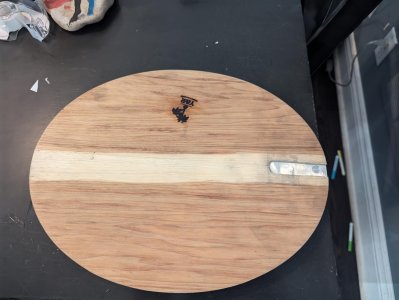Recently, our family when on a trip near Trenton and we made a visit to the air force / aviation museum there. One of my sons found a cribbage board in the gift shop that was produced for the 100th anniversary of the air force and anyway we got it. It is clearly meant to be a wall mount piece, but he wanted it so we could play. It didn't come with any pegs, so I decided it was easy enough to make some
here is a picture of my first prototype

This one is made of brass, but I promised 3 pairs in different colours - probably Aluminum, brass and copper. But it is harder than I thought because of the small size of the work. The holes in the board are drilled 1/8th to a depth of about 3/8th. That means that along the taper about 3/16ths up, the diameter should be 1/8th (both the pegs and the wood will wear). I choose 4 degrees for the taper. But it it way too small to get a tail stock in, and at that size the stock simply bends away from the tool.
To make this prototype, I turned the blank to about a 1/4. Then set the cross at 4 degrees and moved it to start at about 7/64. At that angle it gets to the full diameter at about an inch and a quarter - taking huge flanking cuts as it goes. Hand feed only. The final piece is to be 1"
I think I will do better with the next one
here is a picture of my first prototype
This one is made of brass, but I promised 3 pairs in different colours - probably Aluminum, brass and copper. But it is harder than I thought because of the small size of the work. The holes in the board are drilled 1/8th to a depth of about 3/8th. That means that along the taper about 3/16ths up, the diameter should be 1/8th (both the pegs and the wood will wear). I choose 4 degrees for the taper. But it it way too small to get a tail stock in, and at that size the stock simply bends away from the tool.
To make this prototype, I turned the blank to about a 1/4. Then set the cross at 4 degrees and moved it to start at about 7/64. At that angle it gets to the full diameter at about an inch and a quarter - taking huge flanking cuts as it goes. Hand feed only. The final piece is to be 1"
I think I will do better with the next one




